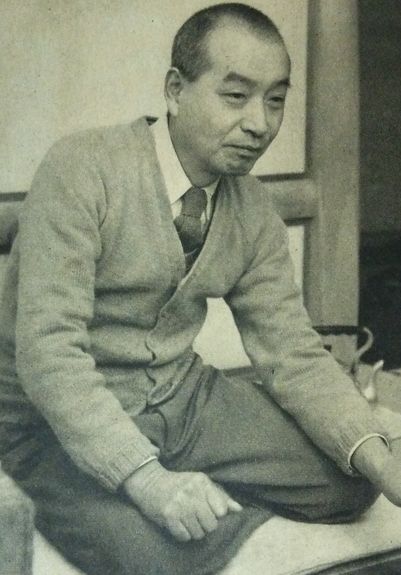Kōsaku Takii on:
[Wikipedia]
[Google]
[Amazon]
 was a noted Japanese
was a noted Japanese
Shunkin Litterature Japonaise entry
Find-a-Grave entry, with photo
{{DEFAULTSORT:Takii, Kosaku Japanese writers 1894 births 1984 deaths Yomiuri Prize winners
haiku
is a type of short form poetry originally from Japan. Traditional Japanese haiku consist of three phrases that contain a ''kireji'', or "cutting word", 17 '' on'' (phonetic units similar to syllables) in a 5, 7, 5 pattern, and a ''kigo'', or s ...
poet, short story writer, and author of the celebrated I novel
The I-novel (, , ) is a literary genre in Japanese literature used to describe a type of confessional literature where the events in the story correspond to events in the author's life. This genre was founded based on the Japanese reception of na ...
''Mugen Hōyō''.
Takii was born in Takayama, Gifu
Takayama City Hall
is a city located in Gifu Prefecture, Japan. , the city had an estimated population of 88,473 in 35,644 households, and a population density of 41 persons per km2. The total area of the city was making it the largest city ...
where his father was a cabinetmaker. At age 13, he lost his mother and two brothers, and was forced to go work in the city's fish markets. In 1909, at age 15, he met haiku poet Kawahigashi Hekigotō and decided to devote his life to poetry. He moved to Tokyo in 1914, where he worked as editor of the haiku magazine ''Kaikō'' (Sea Crimson), and was an occasional student at Waseda University
, mottoeng = Independence of scholarship
, established = 21 October 1882
, type = Private
, endowment =
, president = Aiji Tanaka
, city = Shinjuku
, state = Tokyo
, country = Japan
, students = 47,959
, undergrad = 39,382
, postgrad ...
. Under the influence of Naoya Shiga
was a Japanese writer active during the Taishō and Shōwa periods of Japan, whose work was distinguished by its lucid, straightforward style and strong autobiographical overtones.
Early life
Shiga was born in Ishinomaki, Miyagi Prefecture, ...
, he began publishing fiction in 1919. That same year, he married a prostitute with whom he lived until her death in 1922. His celebrated novel, ''Mugen Hōyō'' (The Infinite Embrace), written as four stories in the years 1921-1924, recounts their relationship.
Following Shiga, Takii moved to Abiko, Chiba, in 1922, then Kyoto
Kyoto (; Japanese language, Japanese: , ''Kyōto'' ), officially , is the capital city of Kyoto Prefecture in Japan. Located in the Kansai region on the island of Honshu, Kyoto forms a part of the Keihanshin, Keihanshin metropolitan area along wi ...
in 1923 and Nara
The National Archives and Records Administration (NARA) is an " independent federal agency of the United States government within the executive branch", charged with the preservation and documentation of government and historical records. It ...
in 1925. In 1930 he struck off with his second wife for Hachiōji
is a city located in the western portion of Tokyo Metropolis, Japan. , the city had an estimated population of 561,344, and a population density of 3000 persons per km2. The total area of the city is .
Geography
Hachiōji is located in the ...
, her home town, and during World War II
World War II or the Second World War, often abbreviated as WWII or WW2, was a world war that lasted from 1939 to 1945. It involved the vast majority of the world's countries—including all of the great powers—forming two opposing ...
worked for the army. All the while he continued to publish essays and stories. In 1959 he became a member of the Japan Art Academy. He received the 1968 Yomiuri Prize
The is a literary award in Japan. The prize was founded in 1949 by the Yomiuri Shinbun Company to help form a "strong cultural nation". The winner is awarded two million Japanese yen and an inkstone.
Award categories
For the first two years, ...
for ''Yashu'', a collection of short stories, and the ''Nihon Bungaku Taisho'' (Grand Prize of Japanese Literature) in 1974 for ''Haijin Nakama'' (Companions of haiku, published in five parts 1969-1973). Takii died of kidney failure
Kidney failure, also known as end-stage kidney disease, is a medical condition in which the kidneys can no longer adequately filter waste products from the blood, functioning at less than 15% of normal levels. Kidney failure is classified as eit ...
and is buried in the Daiyu-ji Temple Cemetery in Takayama, Gifu
Takayama City Hall
is a city located in Gifu Prefecture, Japan. , the city had an estimated population of 88,473 in 35,644 households, and a population density of 41 persons per km2. The total area of the city was making it the largest city ...
.
References
Sources
* Donald Keene, ''Dawn to the West: Japanese literature of the modern era, fiction'', Volume 1, Columbia University Press, 2nd edition, 1998, pages 531-532. .Shunkin Litterature Japonaise entry
Find-a-Grave entry, with photo
{{DEFAULTSORT:Takii, Kosaku Japanese writers 1894 births 1984 deaths Yomiuri Prize winners